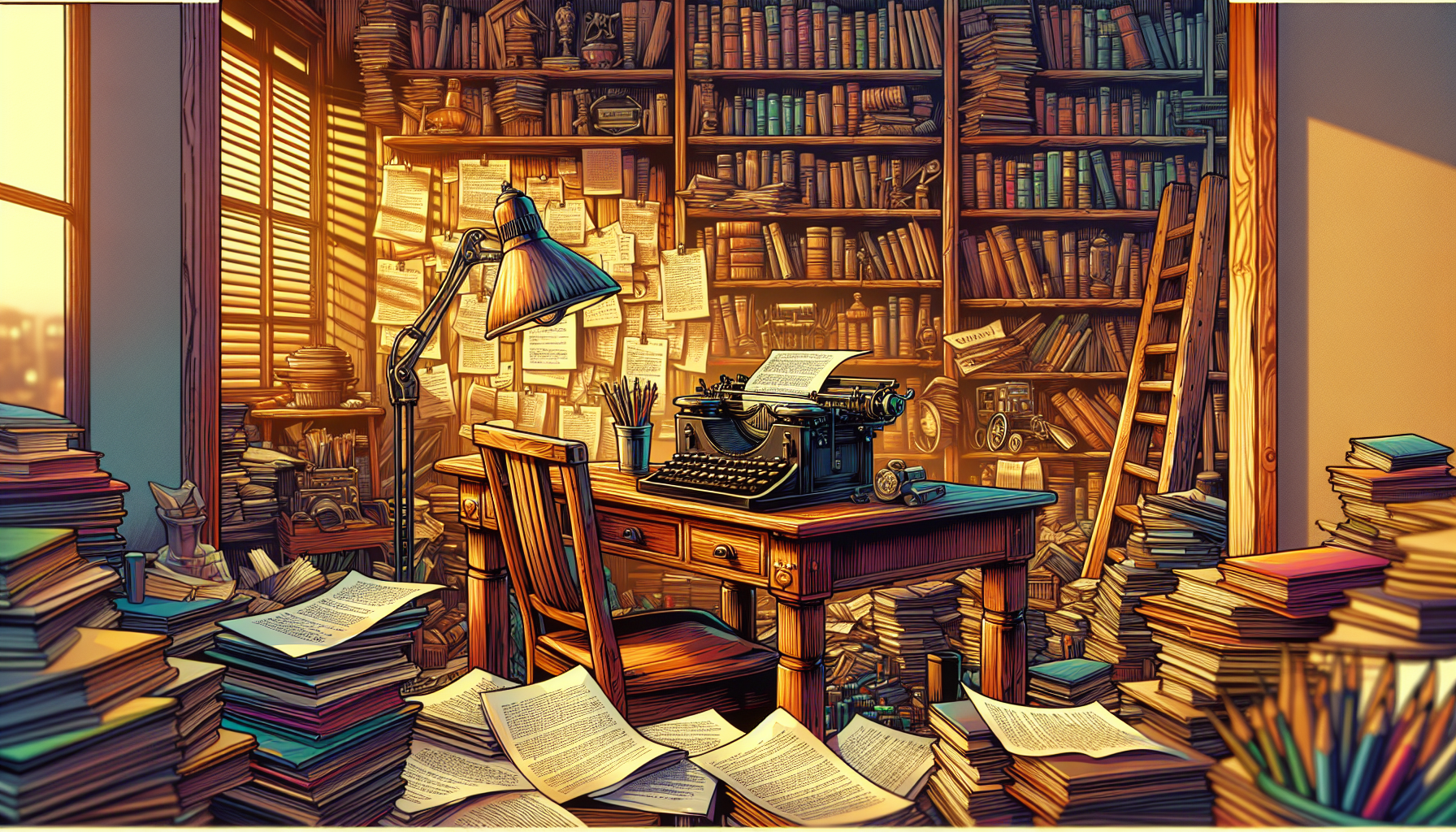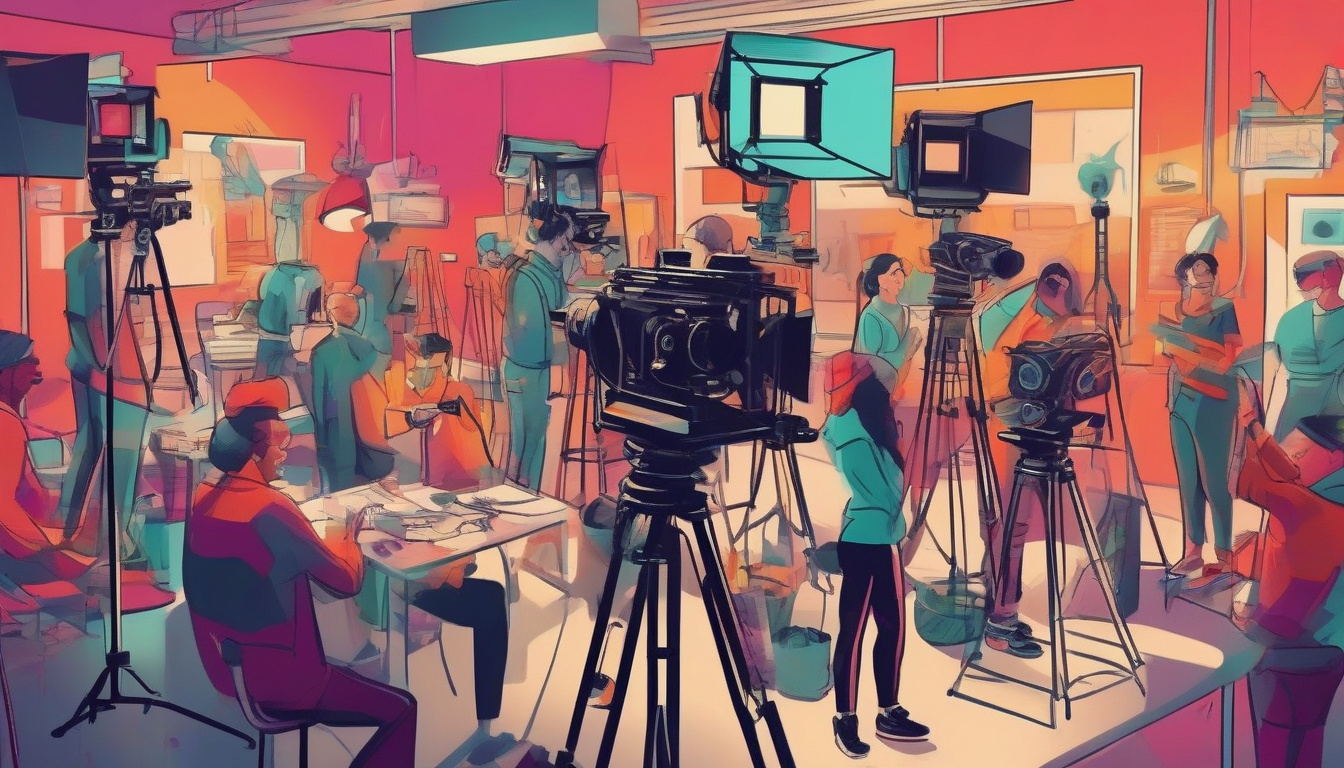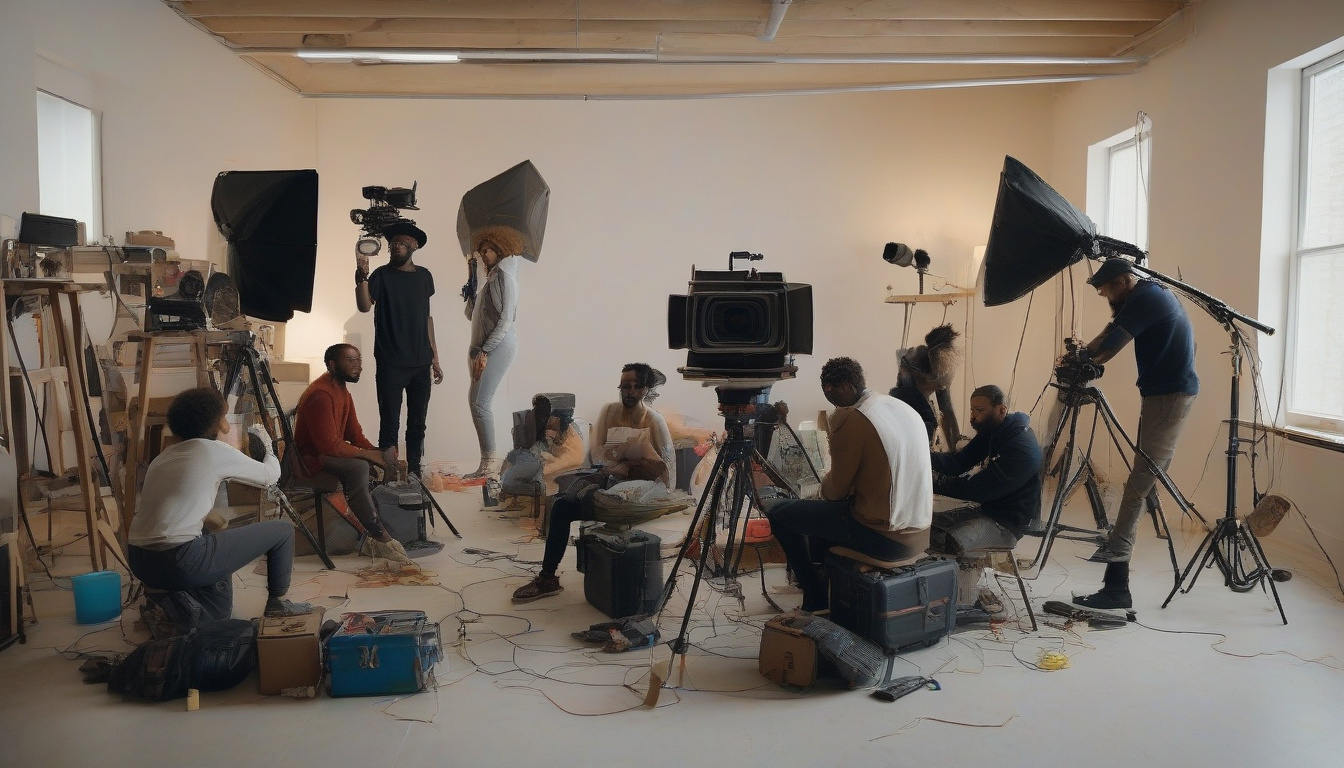
Welcome to the World of Script Writing: A Witty Beginner's Guide
Understanding Script Writing: Foundations for Beginners
Let’s face it, we all think we have a blockbuster movie or a binge-worthy TV series rolling around in our noggin. The trick? Learning the arcane art of script writing. Whether you dream of silver screens, the cozy darkness of theaters, or contributing to the next big streaming addiction, understanding the basics of script writing is your golden ticket. We'll delve into almost everything, from scene descriptions that make you feel like you’re right there (watch out for the virtual popcorn), to crafting characters so real, you'd swear they borrowed your car last Friday. And just for kicks, a whirlwind tour of historical plot twists in the industry's backstory—never say historians don't know how to party.
Essential Tools and Techniques for Successful Script Writing
Now, unless you're still rocking a quill on parchment (we respect your vintage vibe), you'll need some modern gear to bring your script to life. Forget the magic wand; let’s talk Final Draft, Celtx, and other cool gadgets and software that make penning a script less of a headache. Then, huddle up as we guide you through mapping out your story arc (no compass required), spawning protagonists, antagonists, and maybe even a loveable rogue. Plus, how to keep your dialogues snappy enough to outpace a caffeinated squirrel—because no one likes a draggy conversation, right?
Practical Steps to Start Your Script Writing Journey
So, armed with tools and a touch of newfound knowledge, it's time to start slinging ink like a pro. We’ll set you up with a step-by-step game plan to draft your debut. From the terrifying abyss of the first blank page to the triumphant, final “FADE OUT.” Along the rocky road, discover the invaluable role of critique (thicken that skin!), and learn how to schmooze creatively for collaborations. Last but not least, we'll even show you how to toss your script into the ring (or rather, inbox) of a producer or competition. Who knows, the next thank-you speech at an award show could be yours!
Understanding Script Writing: Foundations for Beginners
Welcome, future scriptwriters, to the delightful maze of creation known as script writing! Let’s unpack this suitcase full of curiosity and unravel what exactly makes script writing not just essential, but the backbone of myriad forms of media. From the thunderous applause in a theatre to the binge-worthy weekends spent with Netflix, it all starts with a script. So, grab your notebook (or open your fanciest writing app), and let’s dive into the fascinating world of scripts!
What is Script Writing Anyway?
At its core, script writing is the art of crafting the blueprint for various forms of visual media like films, TV shows, and plays. Imagine it as building the skeleton of a story that others will flesh out with visuals, sounds, and performances. Without a script, actors would be wandering around sets like lost tourists without a map! More than just dialogue, a script orchestrates character movements, emotions, and interactions within meticulously thought-out scenes that guide the entire production team from the sunrise of pre-production to the sunset of the final cut.
The Critical Components of a Script
Thinking about writing a script? Well, here’s what you’ll need to fabricate in that buzzing brain of yours:
- Dialogue: The bread and butter of any script, dialogue is what characters use to communicate. It’s not just words; it’s an opportunity to showcase wit, develop plots, and reveal secrets. Shakespeare did it with style, Tarantino made it cool, and now it’s your turn.
- Character Development: Characters are the heart and soul of your script. They are the vessels through which your story flows. Good characters are not just named entities but have desires, flaws, growth, and maybe a quirky tic or two.
- Scene Descriptions: Set the stage, literally. Scene descriptions are your chance to paint your world. The smell of rain on cobblestones? Include it. The eerie silence in a haunted house? Absolutely necessary. These descriptions help directors and actors understand where they are, both physically and emotionally.
A Brief Romp through the History of Script Writing
Let’s hit the rewind button and zip back to ancient Greece—where it all began with playwrights like Sophocles and Aristophanes (who probably never had to deal with a script leak on Twitter). Fast forward, and we find Shakespeare, Molière, and other playwrights who dominated the realms of romantic tragedies and comedic geniuses. In the flicker of gaslight to the advent of film, screenwriting began to carve its niche. The 20th century welcomed giants like Billy Wilder and Nora Ephron, who penned narratives that we cherish and quote fervently.
The evolution of script writing mirrors the evolution of storytelling across ages and technologies. From parchment, to typewriters, to the latest screenwriting software, each shift has added a new layer to how we tell stories. Moreover, in today’s digital age, script writing has expanded into realms like video games and web series, proving that as long as there are stories to tell, script writing will be there, adapting and thriving.
Why Script Writing Matters More Than Ever
In the golden age of streaming and instant access to content across the globe, script writing is your passport to the world. A well-crafted script is behind every tear shed in a darkened cinema, every laugh echoed in a living room, and every shiver experienced in a moonlit bed. It’s powerful, it’s transformative, and it’s undeniably essential.
So, whether you dream of penning the next big blockbuster or a play that gets standing ovations, understanding the nuts and bolts of script writing is your first step towards the spotlight. Don’t just write; create worlds, forge connections, and perhaps, change perspectives. After all, if you can dream it, you can script it!
Stick with us as we explore more in this guide—next up, discovering the tools of the trade to turn your dream script into reality. Get ready; your scriptwriting journey is just about to begin!
Essential Tools and Techniques for Successful Script Writing
Did someone say ‘script writing’? Ah, the marvelous art of weaving dialogues, characters, and scenes into a tapestry that captivates audiences, be it in dim-lit theatres or cozy living rooms around the globe. But like any craft worth its salt, script writing comes with its toolbox — a kit to turn an idea into dialogue that dances off the page. Sharpen those pencils (or keyboards) and dive into these fundamental instruments and maneuvers every budding scriptwriter should know!
The Scriptwriter’s Arsenal: Must-Have Software and Tools
If you think all you need is a pen and paper, you’re charmingly old-school, but let’s catapult you into today, shall we? In the realm of script writing, software isn’t just about typing up words without smeared ink; these sophisticated tools come loaded with features to structure your scenes, format your script correctly (hello, credibility!), and even suggest plot ideas when your brain feels as barren as a desert.
First off, meet Final Draft. It’s not just an industry standard because it’s fancy — though it is slicker than a greased pig on ice. It’s packed with features that help manage your script’s pacing, structure, and format. Imagine a magical elf that takes care of all the formatting while you ride the wild stallions of your imagination. That’s Final Draft for you.
On a tighter budget? Check out Celtx. It’s like the Robin to your Batman; a loyal sidekick that streamlines the process of script writing without breaking the bank. With Celtx, you can create, edit, and share your scripts with a tap of a button — assuming your Wi-Fi doesn’t bail on you!
Mapping Out Your Masterpiece: Story Outlining
Your script is a skeleton that needs flesh. Start with the bones by outlining. This isn’t your high school outline; this is the blueprint of your future award-winning screenplay. Think of it as drawing the treasure map to El Dorado. You wouldn’t start the journey without knowing the twists and turns, right? The same goes for your story.
An outline allows you to structure your narrative, placing key events and ensuring a balanced pace — basically preventing your story from meandering like a river with commitment issues. Breakdown your acts, sketch out your scenes, and locate where your climaxes should pulse with vigor. This ensures you keep your audience grasping their popcorn in suspense, eyes glued to the screen.
Character Creation: Giving Life to Your Figments
Characters are the heart of your script. They’re more than just names on a page; they’re complex beings with desires, secrets, and quirky traits. Start by knowing them better than your best friend. What’s their favorite ice cream? How do they react to spiders in the bathroom? Trivial? Maybe. Vital for creating depth and relatability? Absolutely.
When fashioning your characters, consider their arcs. Where do they begin emotionally and where must they end by the time the credits roll? This journey is what makes viewers cry, shout, or wish they never have to leave your character’s side.
Dialogue: The Rhythm of Your Script
Dialogue isn’t just about advancing the plot. It’s the rhythm that keeps the tune of your script dancing through the minds of your audience long after they’ve left the theater. Think of it as music; the tempo, the pauses, the crescendos. Good dialogue reveals your character’s true selves, often more so than their actions.
Be natural. No, your characters shouldn’t always say exactly what they mean. Where’s the fun in that? Subtext is your best friend. It’s like flirting — what’s not said is often what matters most. And remember, brevity is the soul of wit. Shakespeare said that, and if it’s good enough for him, it’s good enough for your script.
Pacing: Timing is Everything
Your script should have a pulse. The ebb and flow of the narrative keep the readers and viewers engaged. Too fast, and your audience will need a breather. Too slow, and they’re snoozing before Act 2 rolls in. Weaving exposition naturally, timing pivotal scenes, and mastering the art of ‘leave them wanting more’ at scene closures are just the tip of the iceberg.
Whether you’re crafting a gut-wrenching thriller or a sweet rom-com, pacing helps maintain tension and emotional investment. Think of it as conducting an orchestra — each scene should flow into the next in harmony, building towards a crescendo that’ll have audiences applauding for an encore.
And there you have it! Tools and techniques as essential as a captain’s compass in navigating the stormy yet exhilarating waters of script writing. Grab these with both hands, and steer your creative ship towards the horizon of successful storytelling. Lights, camera, action!
Practical Steps to Start Your Script Writing Journey
So, you want to jump into the glamorous world of script writing, but your experience is about as thin as the plot of a bad soap opera? Fear not! Below, we’ve threaded together a foolproof starter kit to kickstart your narrative adventures. Let’s dive in and turn that ambition into action with some practical steps you can take today!
Step 1: Carve Out Your Script Sanctuary
First things first: find your creative nook. Whether it’s the quiet corner of a café, a peaceful park bench, or your chaotic kitchen table, select a space that fuels your creativity. This will be your script sanctuary, where the magic of your storyboard comes to life. Equip it with essential script writing tools like a sturdy laptop, reliable scriptwriting software (Final Draft and Celtx are the industry sweethearts), and plenty of scribble-friendly notebooks.
Step 2: Unleash the Power of Brainstorming
Now that you have your HQ set up, it’s time to brainstorm. Begin by pouring every fragment of an idea onto paper—don’t worry if they sound like the ramblings of a caffeinated squirrel. Great scripts have been born from less! Consider character quirks, twisty plots, compelling settings, or even overheard conversations. This erratic list is your gold mine for potential scripts.
Step 3: Craft Your First Draft (Yes, It’s Supposed to Be Rough!)
With a heap of ideas in tow, select the one that excites you most and begin fleshing it out into a script. Remember, your first draft is not supposed to be a masterpiece—think of it as the first pancake that might be a bit lopsided. Focus on getting the dialogue to flow naturally and building out your scenes enough to give a sense of pacing. Every great playwright or screenwriter knows the first draft is just about slapping clay on the wheel.
Step 4: Embrace the Art of Rewriting
Arguably, rewriting is where the true script writing begins. It’s time to refine and polish, turning that rough draft into a smooth, audience-ready product. Scrutinize your dialogue for authenticity, ensure your pacing keeps viewers on their toes, and chop off any excess fluff that’s hanging around like a pesky plot hole. This stage is crucial, so don’t rush it—every great script endured its baptism by fire (aka copious amounts of editing).
Step 5: Seek Brutally Honest Feedback
Once you’ve got a solid draft, brace yourself for the onslaught of feedback. Share your script with trustworthy peers, mentors, or if you’re feeling brave, a scriptwriting workshop where feedback is as sharp and frequent as flying arrows. Embrace the constructive criticism; it’s gold dust for refining your script to meet industry expectations.
Step 6: Network and Collaborate
Script writing is not for the solitary—it thrives on collaboration. Attend workshops, screenwriting meetups, and industry events. Mingle with fellow writers, directors, and producers. What starts as a casual coffee chat could lead to partnerships that may launch your script from page to stage or screen.
Step 7: Pitch with Passion (and Preparedness)
Finally, the pitch. This is your moment, don’t just wing it—prepare obsessively. Know your script inside out: be ready to answer any question thrown at you about character motives, plot points, and why your script deserves to be taken from paper to performance. Join pitch fests, utilize online platforms like The Black List, and send your work to competitions. With every pitch, you refine your presentation skills and inch closer to selling your script.
Starting a journey in script writing is no stroll in the park—but hey, nobody said worthwhile adventures ever were! With these beginner steps, each aspiring writer can stride confidently toward creating compelling stories that might just one day light up screens or take center stage. Remember, every script, no matter how celebrated now, began as a blinking cursor on a dauntingly blank page. The key? Start writing, keep rewriting, and never stop networking. Who knows? The next great screenplay might just have your name on it.
Roll the Credits on Your Beginner Script Writing Adventure!
Well, you’ve whizzed through the wild woods of script writing, from deciphering the cryptic glyphs of scene descriptions to slaying the many-headed hydra of dialogue-writing dilemmas. Armed with an arsenal of storytelling tools sharper than a samurai’s screenplay, you stand ready at the precipice of your epic journey into scriptwriting stardom!
Script Your Success Story
Remember, every great writer was once a quivering novice with nothing but a pen and a dream. Whether you’re aiming for the tear-jerky depths of cinematic fame or the laugh-laden realms of sitcom glory, the script is your map, and you, brave scribe, are the compass.
So, engage that brainy brilliance, unleash your inner Shakespeare, and perhaps throw a little Spielberg into the mix as you craft your maiden masterpiece. They say writing is rewriting, so be relentless—chase perfection with the tenacity of a caffeinated cat on a laser pointer.
Applause Awaits
And once that final period marks its territory at the end of your script—stand up, stretch, and take a bow (even if it’s just in front of your cat or commemorative Star Trek mug). You’ve traversed the treacherous but tantalizing terrain of beginning script writing.
Go on, pitch with panache, rewrite with rigor, and may your characters forever linger in the limelight of your audience’s memory. Lights, camera, action—your script writing saga begins now!






